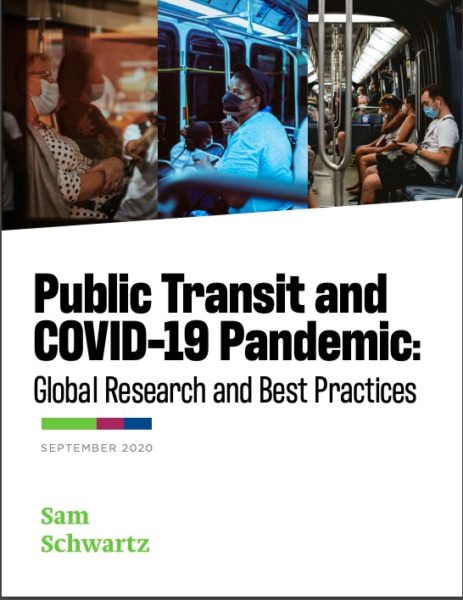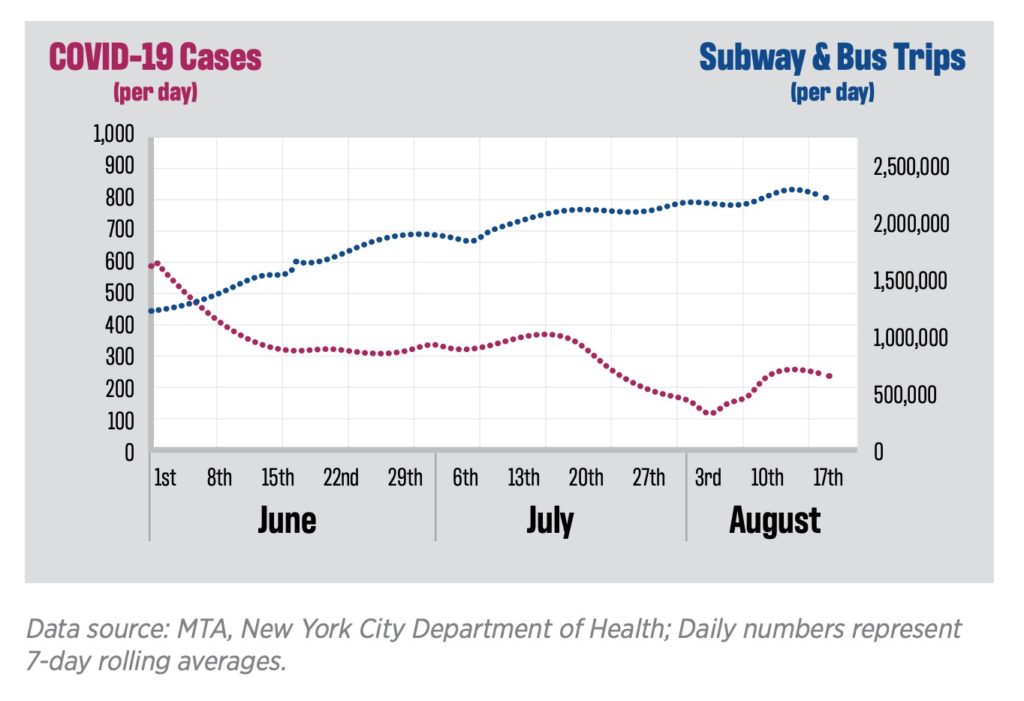
An APTA study led by Sam Schwartz found no link between virus cases and transit usage.
It’s been hard to resist starting every post focusing on the MTA’s current ridership situation and budget woes with the sentence, “It’s been a rough few months for transit,” but it’s been a rough few months for transit. Often associated with the hoi polloi and dirty masses, most transit systems didn’t have reputations for cleanliness before the pandemic and whether fairly or not, quickly become associated with the spread of disease as the pandemic descended on the world.
After a spring in which a spurious MIT study that relied heavily on a correlation/causation error drove the conversation, a group of pro-transit researchers are fighting back, and in a new study released by the American Public Transportation Association, they report no known links between coronavirus cases and public transit.
“As of August 2020, no outbreaks have been traced to public transit in the United States,” the report, authored by New York’s own Sam Schwartz, said. “Based on our data review of case rates and transit usage in domestic cities, the correlation between infection rates and transit usage is weak or non-existent.”
Schwartz’s survey of current pandemic experiences is part of a larger report on transit-related best practices for the COVID-19 era, and you can access the report here as a PDF. It’s very much yet another attempt to change the narrative. The MIT study came out early in April, and despite debunking by Alon Levy and Aaron Gordon, two well-respected voices within the transit community, it set the stage for months of American fears over transit.
Nearly immediately, many one-time transit riders relied upon the MIT study to reinforce ideas that transit isn’t safe and is a source of spread. Even now, seven months after New York started working from home en masse, subway ridership is only around 1.7-1.8 million per day, approximately 30% of normal, and many New Yorkers have said their commute is the biggest barrier to returning to work. The problem is one of psychology and one of science. I understand why people may be hesitant to ride the subway or hop a bus where they may have less control over everyone around them, but sitting in a poorly ventilated office with other people for 8-10 hours a day is more dangerous than the ride shorter to get there. Schwartz is trying to prove it.
Schwartz has to overcome the challenges of proving a negative, and he makes a compelling case. He looks at transit agencies large and small, from NYC to Hartford to the Quad Cities to Northern Kentucky. In each case, after lockdowns eased, increased transit ridership hasn’t corresponded to an uptick in coronavirus cases. Since the spring at least, when mask mandates were instituted and social distancing became the norm, careful transit usage coupled with disinfectant procedures haven’t led to an uptick in positive tests. Here’s Schwartz’s conclusion:
COVID-19 rates appear to be independent of ridership: in Northeast cities such as Hartford, Connecticut and New York, New York where the pandemic has been largely controlled, ridership has grown since peak pandemic low points, but case rates have been significantly reduced. Meanwhile, in Southern, Southwestern, and Midwestern cities, ridership has remained consistent while cases have skyrocketed. These areas are experiencing serious community outbreaks primarily attributed by public health experts to the reopening of bars and restaurants, large gatherings, nursing homes, prisons, and community fatigue of physical distancing practices. In fact, of the fifteen metro areas with the highest cumulative case rates as of August 2020, not one had a typical commuter transit share more than 5%, and most have minimal transit services with very light usage.
What Schwartz cannot ascertain and what will always remain unanswered is whether transit had a role in community spread before we had a better understanding of the science behind COVID-19. It’s generally accepted that the virus was in the U.S. long before the middle of March, and 5.5 million people were riding the subways each day well into early March and long before we knew how effective masks were at slowing the spread. Schwartz even admits as much, noting that “public transit has some characteristics associated with higher COVID-19 transmission risk, including the potential for crowding in enclosed environments on trains, buses and indoor stations.” Ultimately, though, masks, a lack of talking, frequent air replacement and a steady flow of passengers mitigates against risks today whether or not the trains helped spread the virus in March. Based on what we know now, so long as most riders are masked, it’s safe to ride transit.

But will this report matter? That is a question I can’t answer. People’s fears about COVID-19 are fairly baked in right now, and while mayoral candidates are making a show of riding trains, neither Bill de Blasio nor Andrew Cuomo have issued full-throated defenses of subways lately. For better or worse, potential transit riders take their cues from leadership, and leadership is wavering. Still, Schwartz’s study and overview reinforces what many of us have been saying: With proper precautions and a smart approach to personal and communal care, transit trips are no more riskier than any other activity these days.
The final wild card in this psychological battle for the minds of transit riders is, of course, the Trump Administration. Hardly allies to cities and transit riders, the White House has blocked a national order requiring face masks on all transit hubs. Instead, it’s up to localities to approve and enforce these orders. At a local level, the MTA is also prohibited from applying for a federal grant to study how to combat coronavirus spread on transit, as Politico reported late last week.
MTA, the largest transit agency in the country, will be barred from applying for a new federal transportation grant supporting coronavirus research because the Justice Department declared New York City an "anarchist" jurisdiction. @TSnyderDC reporting pic.twitter.com/YxiekkDN9R
— Sam Mintz (@samjmintz) October 9, 2020
We’ll know more about this development on Monday, but this is the heigh of petty politics. Despite its flaws, the MTA is best suited to understand how to combat COVID on transit, and the fact that they can’t apply for this grant because the Trump Administration is playing politics with public health three weeks before the election is a travesty. Still, we know the answers — masks, constant service, less talking, ventilation and high-quality air filters. That’s how transit is safe, and that’s why you could ride the subways today without worrying too much about putting your health at risk.

9 comments
The problem with the “what about before everyone realized corona wasn’t just in China?” part is that this is true globally. It raises questions like “why is Tokyo’s seropositivity rate measured in fractions of one percent?” and “how come there was no corona in Seoul until the supercluster in Daegu exploded?”.
In Japan & other advanced Asian cultures mask waring in public is universal. Secondarily they are also secretive about the truth towards the outside world & therefore someone knew something about what was happening & kept it hush hush as not to be shamed.
This report is great news, but in our new COVID-19 world, all transit agencies including MTA will have to reevaluate anticipated future ridership growth projections for NYC Transit bus and subway, Long Island and Metro North Rail Roads. . NJ Transit will have to do the same. Will there really be 60,000 plus new LIRR riders, to access the future LIRR East Side Access Grand Central Terminal? No one can predict how many years it will take to come even close to a return to pre COVID-19 ridership numbers. Who knows how many more years will pass, before ridership numbers will significantly increase beyond pre COVID-19 numbers. More people are going to continue telecommuting from home on a permanent basis. There will be fewer face to face meetings and conferences, with increased useage of Zoom and other teleconference technologies. The growing crime rate and decline for quality of life in NYC will make working, shopping, dinning, visiting or living in Manhattan even less desirable. Fewer people may travel via public transit to events at Lincoln Center, Radio City Music Hall, Broadway Theaters or Madison Square Garden. Many Manhattan based corporations are considering relocating employees to satellite offices in the surrounding suburbs. The same is true for those from out of town needing to conduct business in NYC.
(Larry Penner — transportation advocate, historian and writer who previously worked for the Federal Transit Administration Region 2 New York Office. This included the development, review, approval and oversight for billions in capital projects and programs for the MTA along with 30 other transit agencies in NY & NJ).
Not sure I agree if most will work from home as predicted. There are certain aspects of being in an office that cant be reproduced at home. Also lets look at this another way – if most work from home then there won’t be a need for any CBD & that impact will be felt in residential property taxes in every community across the nation. It will forever effect the airline & hotel industries as they will be totally dependent on tourism & leisure travelers who are price sensitive. This will cause fewer choices & higher prices.
Companies will be encouraged to embrace work from home permaently since they can now save hundreds of thousands or even millions on office rent. Large office buildings will go the way of suburban shopping malls.
Great so the NYC subway is dead forever then. It’s viability depends on millions of people commuting into Manhattan. What are we going to do about it? Lie down and let this wonder of the world die?
By that same logic that would be true in every metropolis across the globe not just NYC. And therefore every metro will need to reevaluate there tax structure if retail & most white collar jobs shift online.
You will also see most universities go under as well if this continues as no person will pay tens of thousands to sit in virtual zoom classes & this will impact South Bend & all the other college towns across the country.
Interesting how the MIT report is blasted as a “spurious … study that relied heavily on a correlation/causation error”, then another APTA study is put forward which also purely relies on correlation! Hmm, I wonder if the APTA would be biased toward finding a certain result?
“Interesting how the MIT report is blasted as a “spurious … study that relied heavily on a correlation/causation error”, then another APTA study is put forward which also purely relies on correlation! Hmm, I wonder if the APTA would be biased toward finding a certain result?”
Perhaps, but the MIT study also forever altered & possibly damaged an industry without solid evidence. So what was the APTA to do – cave & except a study that was falty ?